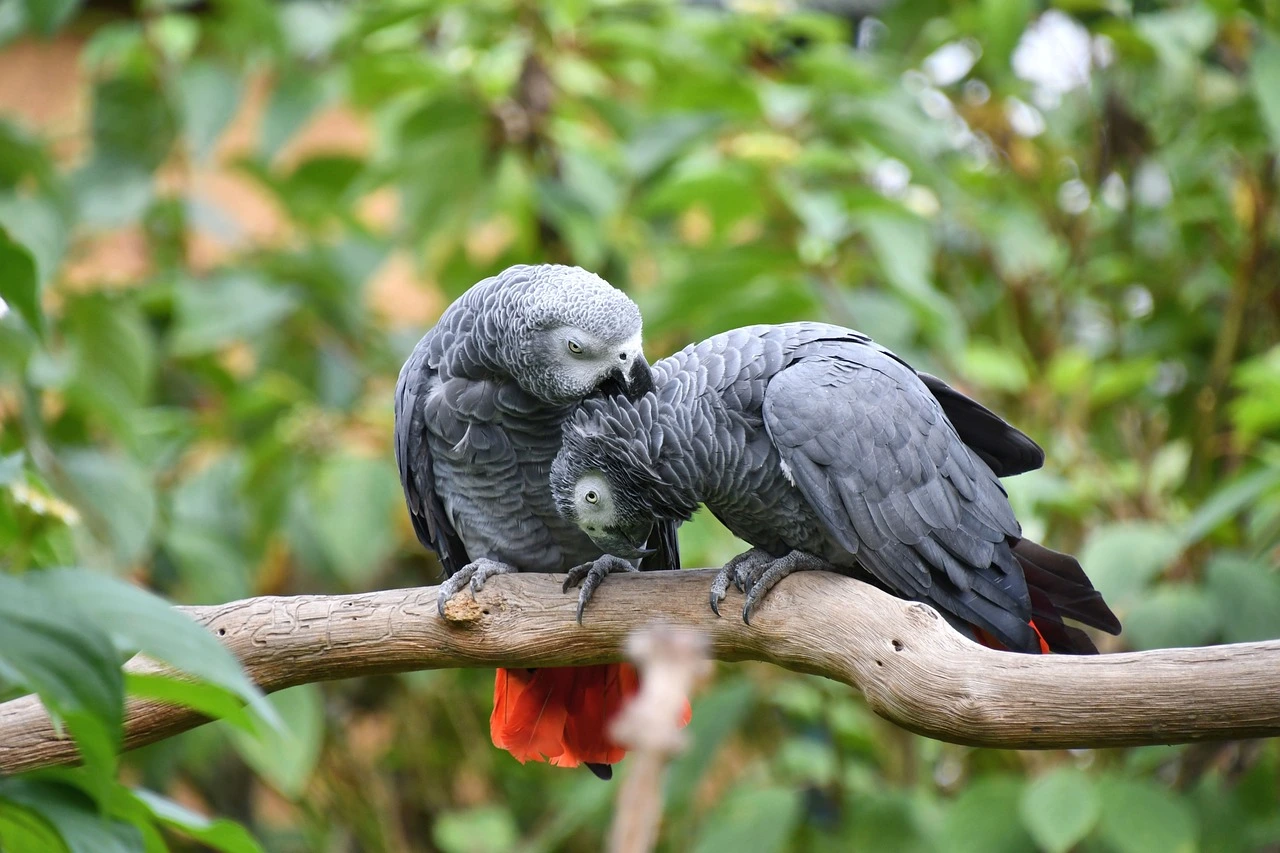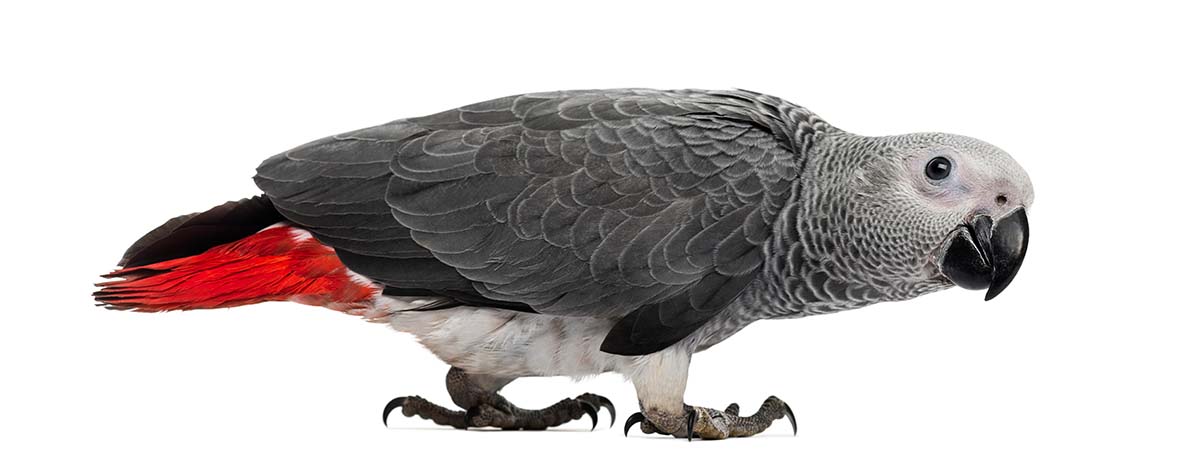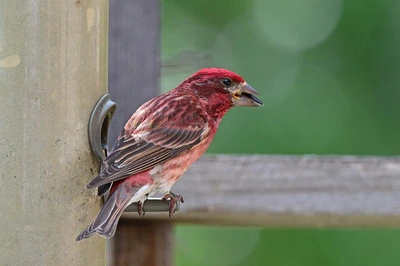
African Grey Parrots Make Great Pets
African Greys are beautiful, intelligent, affectionate, and gentle birds.
Since they are so intelligent, African Grey Parrots can be easily bored if not provided with regular stimulation and challenges. Regular attention and a colourful environment with a variety of toys, exercise equipment and an array of food are necessary to keep your Grey happy.
Parrots require consistent attention along with an interesting environment that includes positive mental challenges, such as a wide variety of interesting toys to keep them stimulated.
Come into Buckerfield’s to get everything you need for your African Grey.
Interesting African Grey bird facts
-
African Greys are good choices for owners who cannot tolerate consistent loud noise. These birds are quieter than other bird species.
-
Greys can live more than 50 years and the average size is 10-15 inches from head to end of tail.
-
African Greys love to learn tricks and can learn a large vocabulary by imitating sounds and human speech.
-
Normal sleeping position is sleeping on one foot with their head tucked under their wing.
-
Their feather dander and dust from their powder down feathers can cause or aggravate allergies.
Tips for keeping your African Grey happy
-
African Greys can become overly attached to one person if they are not properly socialized to being handled by all family members. It is important to acclimate your bird to as many people as possible. This will make your bird a better socialized, more outgoing pet.
-
Offer a large assortment of toys, and a variety of food, in the morning and evening. A bored bird is often destructive and does not make an ideal pet.
-
Keep a routine for your Grey by making sure feeding, playtime and bedtime are at about the same time every day.
-
When no one is home, leave on a radio or television for background noise so your bird’s environment does not become too quiet.
-
Be sure to interact and spend quality time with your bird. Try cuddling on the couch while watching TV together or letting your bird keep you company while you work.
-
Close windows and doors before you let your bird out of the cage. Ensure your bird doesn’t chew on anything harmful and avoid the use of any product that might cause toxic fumes, such as pesticides, non-stick cooking spray, cleaning products, perfumes and other aerosols.

Signs of a healthy bird
Illness in birds is difficult to detect, so preventive care helps detect serious problems before they develop.
-
Bright, clear eyes
-
A clean cere, the area above the bird’s beak
-
An upright posture
-
A full chested appearance
-
Active movement around the cage
-
Clean legs and vent
-
Smooth well groomed feathers
-
A good appetite
Signs of an unhealthy parrot
To keep your pet from suffering long-term health risks, keep an eye on their daily activities and appearance. If you notice any of these signs, contact your avian veterinarian:
-
Fluffed, plucked or soiled feathers
-
A loss of appetite or weight loss
-
Sleeping all the time
-
A change in appearance or quantity of stool
-
Listlessness
-
Drooping wings
-
Lameness
-
Runny eyes or nose
-
If your bird stops talking or singing
-
Laboured breathing, wheezing or coughing
-
Food regurgitated onto cage floor
Choosing a cage for your parrot
-
Make sure the cage has room for your bird to spread their wings without touching the cage sides. A cage that measures 2’x 2’ x 3’ high is the minimum size for a single Grey, and bigger is better.
-
Bar spacing should be about ½ inch and choose a cage with mostly horizontal bars so your bird will be able to climb the cage walls more easily and move from one perch to another.
-
Things to consider: Is the door wide enough to get your hand in and out comfortably? Will your bird’s food and water dish fit through? What direction does the door open? Is it escape-proof? Is it safe enough for your bird?
-
Make sure the cage tray slides in and out for easy cleaning. Use newspaper or reuse printer paper to line tray and change daily. Bacteria can lead to a sick bird if you are not careful.
-
The floor of the cage should have a grill that will keep your bird out of the debris that falls to the bottom of the cage. The grill should be about 4 inches from the bottom of the cage.
-
Place cage in a secure well-lit corner with one solid wall behind cage to ensure your bird’s sense of security, and out of direct sunlight. Make sure your bird can see the entire room and avoid any areas near a cooling or heating system.
-
Drastic temperature changes can stress your bird and lead to illness.
Bedding
-
The simplest and best bedding is newspaper
-
Readily available, cost effective (free) and absorbent
-
When choosing a cage select one that will accommodate a standard size newspaper. The easier your bedding is to replace the more often you will clean your cage. Folding and cutting newspaper to fit is a time consuming nuisance.
-
Layer the sheets of newspaper so you are able to do a quick clean-up by changing the top layer and removing the remains of food and droppings without a full cleaning.
Food and water dishes
-
Parrots enjoy open ceramic bowls that allow them to sit on the edge and pick and choose what they want to eat.
-
Heavy crock style and dishes that lock into place are less likely to get tipped by your mischievous Grey and still allow them to perch on the edge.
Perches
Perches are a place of rest and comfort as well as a place for foot exercise.
-
Look for perches that offer a variety of diameters and materials so your bird’s feet won’t get tired of standing on the same thing day after day.
-
Varying the perch diameters and materials exercises the feet, varies the pressure across different parts of the foot, and keeps the skin of the feet and nails evenly worn.
-
All perches should be washed and disinfected each week.
-
Sandpaper perches are not appropriate because the surface can rub raw patches of your bird’s feet.
-
Birds spend almost all of their lives standing, so keeping their feet happy and healthy is important.
-
Bird owners can buy perches made from manzanita branches, PVC pipe, tightly woven rope or concrete. Natural wood branches may be ideal for your parrot because the size can vary in a single perch. Make sure PVC perches have been lightly scuffed with sandpaper to improve traction and to prevent slipping.
Games for your bird
You can play games with your Grey to amuse them and yourselves. Here are some examples:
-
The Shell Game: Hide a favorite treat under a paper muffin cup and let your bird guess where it is hidden. When they find the treat let them eat it.
-
The Great Escape: Offer your bird a clean knotted piece of rope or leather and see how long it takes to untie the knots.
-
The Mechanic: Give your bird a clean nut and bolt with the nut screwed on and see how long it takes to undo the nut. Make sure the nut and bolt are large enough that your pet won’t swallow accidentally.
-
Peek-a-Boo: Place a towel over your bird, then let them work their way out from under it. Repeat if necessary!
-
Tug-of-War: Give your bird one end of an empty paper towel roll and tug gently. Chances are your parrot won’t easily let go!
Choosing the Right Toys
Depending on your bird’s mood they can be captivated by an intricate toy with many pieces of wood or large beads strung together on a rope or piece of leather or a simple empty paper towel roll.
-
Size: Large toys can be intimidating, making birds less likely to play with them, while smaller toys can be easily destroyed and they can injure themselves.
-
Safety: Is the toy safe? Good choices include sturdy wooden toys strung on chains, leather, rope, or made of rope. Make sure nails are trimmed to prevent snagging on rope. Replace a toy when worn or damaged to prevent injuries.
-
DIY: Make you own wooden toys using untreated lumber, string some Cheerios or raw pasta on a piece of leather for them to play with (and destroy!)
-
Unsafe toys: Watch for brittle plastic that can easily be shattered by a beak, lead weighted toys that can be cracked open to expose the dangerous lead, or loose chains that could catch a toenail or beak, or could trap toes or tongues.
Your bird will spend most of the time in their cage but will also need a lot of time out of the cage to exercise and enjoy a change of scenery. A play gym can help keep your pet stay physically and mentally active.
-
Place the gym safely away from other curious pets, ceiling fans, open windows, and other household hazards.
-
Remember, your bird can get into lots of trouble on its own, so while they play, they need supervision. Place the gym in a spot where you can keep an eye on it making sure your bird does not get into trouble.
-
Consider placing the gym by a window where they can watch the wild birds outside or wherever you are watching TV. Not much fun working out by yourself!
Grooming
Individual birds have a bathing preference. Some like to be sprayed with water and others like to jump into a shallow bowl filled with lukewarm water.
-
Your bird should be able to bathe regularly and have their nails and flight feathers trimmed periodically to ensure safety.
-
A healthy bird with enough chew toys can do a remarkable job of keeping their beak trimmed. If your bird’s beak becomes overgrown, consult an avian veterinarian — it might be a sign of illness.
-
A parrot’s beak contains many blood vessels, so beak trimming is best left to an expert.
-
Mist your bird with clean warm water to encourage them to preen and condition their feathers or hold them under gentle running water to get wet.
-
Supervision is necessary while wet, and your companion should be completely dry before perching for the night.
-
Never put shampoo, lotion or dust on your bird’s feathers. If the feathers look unhealthy or dirty, visit your veterinarian. Carelessness about their own appearance could be a sign of illness.
-
If you see your bird ruffling and straighten feathers, they are preening. Parrots will take oil from a gland at the base of the tail and spread it on their feathers. A healthy bird grooms each feather each day.
Nail Trimming
-
Parrots need their nails trimmed to prevent injury by catching nails on toys or perches. Nails should be kept sharp enough to grip perches but not sharp enough to hurt or poke holes in your skin when handling your bird.
-
Hold your bird safely in a towel when trimming nails.
-
You will need to remove only the hook, in the smallest increments possible, and stop trimming before you reach the quick. You may file the nail with an emery board to reshape after clipping.
-
You should never attempt nail trimming until an experienced vet, groomer, or fellow bird owner shows you how.
-
If you happen to cut the nails too short and they start to bleed, apply styptic powder, cornstarch or flour, followed by direct pressure, to stop the bleeding.
Wing Trimming
-
Clip your bird’s wings regularly to prevent your pet from flying away, into a window, mirror, or wall when out of the cage.
-
An added benefit is that the inability to fly will make your bird more manageable and more dependent on you for transportation.
-
Your bird still needs to be able to glide safely to the ground if taking flight from the cage top or play gym.
-
At least once a year, your bird loses and replaces feathers until every feather is new. This is a normal process called molting. Old worn feathers are pushed out by incoming new ones.
-
Wing trimming is a task that must be performed carefully to avoid injuring your pet. Be sure to trim both wings evenly and that wings are trimmed after a molt. You may want to enlist the help from your avian veterinarian to show you how the first time.
Diet
-
Your Grey’s diet should contain equal amounts of seeds, pellets, grain and legumes, fresh dark green or orange vegetables and fruits, you can supplement with small amounts of well-cooked meat or eggs. You can also try raw or cooked pasta, toast, rice, cooked beans or unsweetened breakfast cereal.
-
The key to a healthy diet is variety. Try broccoli, apple slices, carrots, yams, red peppers, dandelions, spinach, cantaloupe, pear slices, chilli peppers, cherries… the list goes on and on.
-
Pelleted diets are easy to serve and have all the nutrients your bird needs. You can offer pellets with fresh seed and fresh fruits and vegetables.
-
Provide the freshest food possible and remove any partially eaten or discarded food before it can spoil.
-
Store your birdseed in the freezer to keep it fresh and from becoming infested with seed moths.
-
To ensure your parrot has enough seeds, inspect dish frequently and empty it of seed hulls.
-
Do not feed birds, rhubarb, avocado, fruit seeds, caffeine or alcohol as well as highly salted, sweetened or fatty foods. Avoid chocolate as it could kill your pet.
-
Provide clean fresh water daily.
To check if birdseed is fresh, try sprouting. Soak seeds overnight in warm water. Drain and place seeds in a closed cupboard at room temperature for 24 hours. Rinse the sprouted seeds and offer them to your bird. If the seeds don’t sprout, they are not fresh.
Household Hazards
As a responsible bird owner, you want to provide your pet the best care possible, and that includes bird-proofing your home. What seems like home sweet home to you can be unsafe for your pet.
Potential dangers to a pet bird are everywhere. Pay attention if your bird takes an interest in your jewelry. Consider hazards if you’re planning to remodel, have your home fumigated, or have other pets in the house. A curious dog or cat could chase your bird, bite, or even break a leg.
Bathroom
-
Your bird could fall into an uncovered toilet bowl and drown
-
Could become ill if they get into prescription or over the counter drugs
-
Could injure themselves by flying into the mirror or by chewing on the blow dryer or razor cord
-
Could become ill from exposure to fumes from perfume, hairspray or cleaning products, such as bleach, air freshener or toilet bowl cleaner
Kitchen
-
An unsupervised bird could fly or fall into the trash can, climb into the oven, dishwasher, freezer or fridge and be forgotten
-
Your bird could land on a hot stove element, fall into a hot frying pan or pot cooking on the stove
-
Your bird could eat foods unsafe for them like chocolate, avocado or rhubarb and be poisoned
Living Room
-
Your bird could be accidentally sat on when hiding under a blanket or pillow or under a reclining chair
-
Could become tangled in drapery pull cords or venetian blinds
-
Could fly out an open patio door or window or fly into a wall, a closed window or door and get hurt
Have more questions? Visit your local Buckerfield's and we'll be happy to help!



